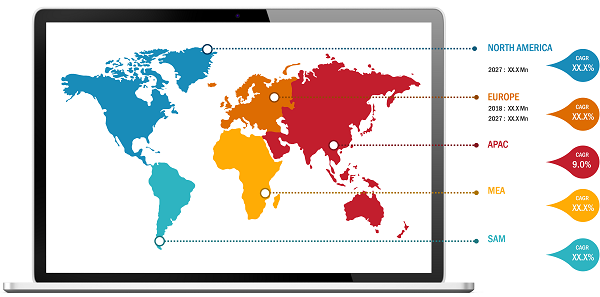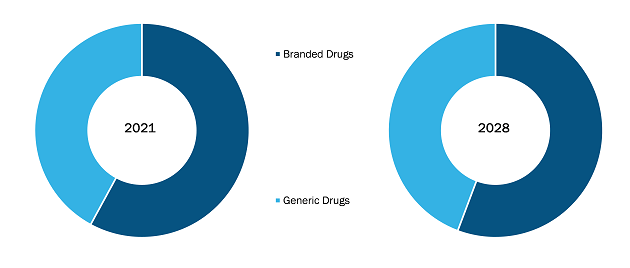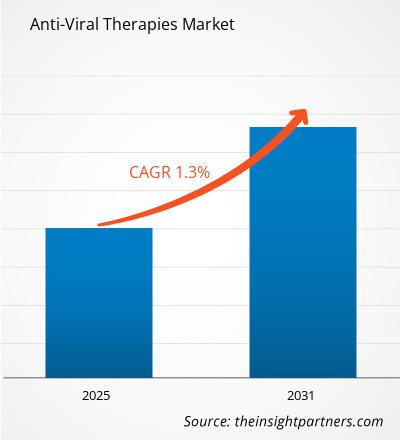Der weltweite Markt für antivirale Therapien wird voraussichtlich von 47.228,91 Millionen US-Dollar im Jahr 2021 auf 82.928,76 Millionen US-Dollar im Jahr 2031 wachsen; Es wird geschätzt, dass es von 2022 bis 2031 mit einer jährlichen Wachstumsrate von 8,4 % wachsen wird.
Antivirale Therapien umfassen die Entwicklung einer Behandlung für Virusinfektionen. Es gibt verschiedene Strategien zur Entwicklung einer antiviralen Therapie, darunter direkt wirkende antivirale Medikamente, die auf virale Proteine, Enzyme oder Nukleinsäuren abzielen; passive Antikörper, die zirkulierende Viren neutralisieren; und Medikamente, die auf zelluläre Proteine oder Prozesse abzielen, die für die Virusreplikation wesentlich sind.
Der Markt für antivirale Therapien wird auf die steigenden F&E-Ausgaben in Pharmaunternehmen und die zunehmende staatliche Unterstützung für Forschungsaktivitäten zurückgeführt und klinische Studien. Allerdings behindern die hohen Kosten der Arzneimittelentwicklung das Wachstum des Marktes.
Der Markt für antivirale Therapien ist nach Typ und Anwendung segmentiert , Wirkmechanismus und Geographie. Der Bericht bietet Einblicke und eine eingehende Analyse des Marktes für antivirale Therapien und betont dabei verschiedene Parameter wie Markttrends, technologische Fortschritte und Marktdynamik sowie die Analyse der Wettbewerbslandschaft führender Marktteilnehmer.
Lukrative Regionen des Marktes für antivirale Therapien
 < /p>
< /p>
Market Insights
Steigende F&E-Ausgaben in Pharmaunternehmen fördern das Marktwachstum für antivirale Therapien
Forschung und Entwicklung (F&E) ist ein wesentlicher Bestandteil der Geschäftstätigkeit eines Unternehmens. Pharmaunternehmen konzentrieren sich auf Forschung und Entwicklung, um neue Medikamente mit verbessertem medizinischem und kommerziellem Potenzial einzuführen. Diese Unternehmen investieren hauptsächlich in F&E-Aktivitäten mit dem Ziel, qualitativ hochwertige und innovative Produkte auf den Markt zu bringen.
F&E-Investitionen großer Pharmaunternehmen
Hinweis: Der aktuelle Umrechnungskurs wird berücksichtigt.
Quelle: Jahresberichte und The Insight Partners Analysis
Die F&E-Ausgaben der biopharmazeutischen Unternehmen sind im Laufe der Jahre gestiegen. Laut dem Bericht der Pharmaceutical Research and Manufacturers of America (PhRMA) sind die F&E-Ausgaben der biopharmazeutischen Unternehmen von US-Dollar gestiegen 49,6 Milliarden US-Dollar im Jahr 2012 auf 58,8 Milliarden US-Dollar im Jahr 2015. Im Geschäftsjahr 2014–2015 gehörten 16 Pharmaunternehmen zu den 50 größten Unternehmen der Welt, gemessen an den gesamten F&E-Investitionen. Novartis, Roche, Johnson & Johnson, und Pfizer gehören zu den zehn führenden Unternehmen, die weltweit in Forschung und Entwicklung investieren. Darüber hinaus investierte Astellas Pharma im Jahr 2021 1803,70 Millionen US-Dollar in die Forschung und Entwicklung neuer und fortschrittlicher Arzneimittel. Daher wird mit einem Anstieg der Forschungs- und Entwicklungsausgaben gerechnet den Markt für antivirale Therapien im Prognosezeitraum vorantreiben.
Typbasierte Einblicke
Je nach Typ ist der Markt für antivirale Therapien in Generika und Markenmedikamente unterteilt. Das Segment der Markenmedikamente hatte im Jahr 2021 einen größeren Marktanteil; das Segment der Generika dürfte jedoch einen größeren Marktanteil haben registrieren Sie im Prognosezeitraum eine höhere CAGR.
Markt für antivirale Therapien, nach Typ – 2021 und 2031 Basierend auf dem Wirkmechanismus ist der Markt für antivirale Therapien in Nukleotid-Polymerase-Inhibitoren, Reverse-Transkriptase-Inhibitoren, Protease-Inhibitoren und andere unterteilt. Das Segment der Nukleotid-Polymerase-Inhibitoren hielt den größten Marktanteil Außerdem wird erwartet, dass das Segment der Reverse-Transkriptase-Inhibitoren im Prognosezeitraum aufgrund seiner Wirksamkeit bei der Reduzierung der Ausbreitung von Virusinfektionen die höchste CAGR auf dem Markt verzeichnen wird. Daher wird erwartet, dass der Bedarf und die Verwendung von Reverse-Transkriptase-Inhibitoren im Jahr zunehmen in den kommenden Jahren, was voraussichtlich das Marktwachstum auf der ganzen Welt ankurbeln wird. Je nach Anwendung ist der globale Markt für antivirale Therapien in HIV, Hepatitis, Herpes, Virusgrippe und andere Anwendungen unterteilt. Das HIV-Segment hatte im Jahr 2021 den größten Marktanteil. Darüber hinaus Es wird geschätzt, dass das Hepatitis-Segment im Prognosezeitraum die höchste CAGR verzeichnet. Der globale Markt ist geografisch in Nordamerika (USA, Kanada und Mexiko), Europa (Großbritannien, Deutschland, Frankreich, Italien, Spanien und übriges Europa) und den asiatisch-pazifischen Raum (China) unterteilt , Japan, Indien, Australien, Südkorea und der übrige asiatisch-pazifische Raum), der Nahe Osten und Afrika (VAE, Saudi-Arabien, Afrika und der übrige Nahe Osten und Afrika) sowie Süd- und Mittelamerika (Brasilien, Argentinien und der Rest von Süd- und Mittelamerika). Der Markt für antivirale Therapien im asiatisch-pazifischen Raum wird im Prognosezeitraum voraussichtlich am schnellsten wachsen. Es wird geschätzt, dass der Markt im Prognosezeitraum aufgrund der aufstrebenden Pharmaindustrie in China, Japan, Indien und andere Länder im asiatisch-pazifischen Raum. Das zunehmende Auftreten von Viruserkrankungen in der Region und die zunehmenden Produktentwicklungen lokaler und internationaler Marktteilnehmer dürften das Marktwachstum begünstigen. Darüber hinaus gehört Chinas Pharmaindustrie zu den größten Pharmaindustrien der Welt Weltweit. Das Land verzeichnete ein deutliches Wachstum bei pharmazeutischen Wirkstoffen Herstellung, Wettbewerbsfähigkeit, Innovationen und endgültige Dosierungsbildung. Daher zeigen die meisten multinationalen Unternehmen Interesse am chinesischen Markt für Arzneimittelverkäufe. Zunehmende Bemühungen von Regierungen verschiedener Länder sowie Pharma- und Biotech-Unternehmen zur Behandlung von COVID-19-Patienten dürften das Wachstum des Marktes für antivirale Therapien im Prognosezeitraum vorantreiben. In den USA die FDA hat die Notfallzulassung experimenteller Arzneimittel genehmigt. Klinische Studien mit Remdesivir, monoklonal Antikörper, Interferone, ACE-Hemmer und Hydroxychloroquin wurden alle in den USA registriert. Darüber hinaus unternehmen Pharmaunternehmen im Land enorme Anstrengungen, Medikamente und Impfstoffe für die Behandlung von COVID-19-Patienten zu entwickeln. Im Juni 2021 Wissenschaftler der Universität Oxford hatten bestehende Medikamente als Therapien für COVID-19-Patienten getestet. Darüber hinaus hat die Europäische Kommission im Juli Remdesivir zugelassen und ist damit das erste zugelassene Medikament zur Behandlung von COVID-19 in der Europäischen Union. Zu den wichtigsten Akteuren auf dem Markt für antivirale Therapien gehören AbbVie Inc.; Abbott; F. Hoffmann-La Roche Ltd; Bristol-Myers Squibb Company; Johnson & Johnson Services, Inc.; Merck & Co., Inc. ; Gilead Sciences, Inc.; GlaxoSmithKline plc; und Aurobindo Pharma Limited.
Mechanismus handlungsbasierter Erkenntnisse
Anwendungsbasierte Erkenntnisse
Firmenprofile
- Historische Analyse (2 Jahre), Basisjahr, Prognose (7 Jahre) mit CAGR
- PEST- und SWOT-Analyse
- Marktgröße Wert/Volumen – Global, Regional, Land
- Branche und Wettbewerbsumfeld
- Excel-Datensatz


- Digital Pathology Market
- EMC Testing Market
- Asset Integrity Management Market
- Grant Management Software Market
- Water Pipeline Leak Detection System Market
- Latent TB Detection Market
- Non-Emergency Medical Transportation Market
- Transdermal Drug Delivery System Market
- Sweet Potato Market
- Artificial Intelligence in Healthcare Diagnosis Market

Report Coverage
Revenue forecast, Company Analysis, Industry landscape, Growth factors, and Trends

Segment Covered
This text is related
to segments covered.

Regional Scope
North America, Europe, Asia Pacific, Middle East & Africa, South & Central America

Country Scope
This text is related
to country scope.
Häufig gestellte Fragen
Key companies in the Anti-Viral Therapies Market are - AbbVie Inc., Abbott, F. Hoffmann-La Roche Ltd, Bristol-Myers Squibb Company, Johnson & Johnson Services, Inc., Merck and Co., Inc., Gilead Sciences, Inc., GlaxoSmithKline plc, Aurobindo Pharma
The report can be delivered in PDF/PPT format; we can also share excel dataset based on the request.
The Anti-Viral Therapies Market is expected to register a CAGR of 1.3% from 2025-2031.
The major driving factors supporting the Anti-Viral Therapies Market growth are- Increasing Incidences of Viral Infection, Government Initiatives and Financing, and Advancements and Development in Antiviral Therapy
Key Future Trends in the Anti-Viral Therapies Market are- Shift Toward Broad-Spectrum Antivirals, mRNA and Gene Therapy Innovations, and Increased Focus on Personalized Medicine in Antiviral Therapy
Some of the customization options available based on request are additional 3–5 company profiles and country-specific analysis of 3–5 countries of your choice. Customizations are to be requested/discussed before making final order confirmation, as our team would review the same and check the feasibility.
Trends and growth analysis reports related to Life Sciences : READ MORE..
The List of Companies - Anti- Viral Therapies Market
- AbbVie Inc.
- Abbott
- F. Hoffmann-La Roche Ltd
- Bristol-Myers Squibb Company
- Johnson & Johnson Services, Inc.
- Merck and Co., Inc.
- Gilead Sciences, Inc.
- GlaxoSmithKline plc
- Aurobindo Pharma
- AstraZeneca
The Insight Partners performs research in 4 major stages: Data Collection & Secondary Research, Primary Research, Data Analysis and Data Triangulation & Final Review.
- Data Collection and Secondary Research:
As a market research and consulting firm operating from a decade, we have published and advised several client across the globe. First step for any study will start with an assessment of currently available data and insights from existing reports. Further, historical and current market information is collected from Investor Presentations, Annual Reports, SEC Filings, etc., and other information related to company’s performance and market positioning are gathered from Paid Databases (Factiva, Hoovers, and Reuters) and various other publications available in public domain.
Several associations trade associates, technical forums, institutes, societies and organization are accessed to gain technical as well as market related insights through their publications such as research papers, blogs and press releases related to the studies are referred to get cues about the market. Further, white papers, journals, magazines, and other news articles published in last 3 years are scrutinized and analyzed to understand the current market trends.
- Primary Research:
The primarily interview analysis comprise of data obtained from industry participants interview and answers to survey questions gathered by in-house primary team.
For primary research, interviews are conducted with industry experts/CEOs/Marketing Managers/VPs/Subject Matter Experts from both demand and supply side to get a 360-degree view of the market. The primary team conducts several interviews based on the complexity of the markets to understand the various market trends and dynamics which makes research more credible and precise.
A typical research interview fulfils the following functions:
- Provides first-hand information on the market size, market trends, growth trends, competitive landscape, and outlook
- Validates and strengthens in-house secondary research findings
- Develops the analysis team’s expertise and market understanding
Primary research involves email interactions and telephone interviews for each market, category, segment, and sub-segment across geographies. The participants who typically take part in such a process include, but are not limited to:
- Industry participants: VPs, business development managers, market intelligence managers and national sales managers
- Outside experts: Valuation experts, research analysts and key opinion leaders specializing in the electronics and semiconductor industry.
Below is the breakup of our primary respondents by company, designation, and region:

Once we receive the confirmation from primary research sources or primary respondents, we finalize the base year market estimation and forecast the data as per the macroeconomic and microeconomic factors assessed during data collection.
- Data Analysis:
Once data is validated through both secondary as well as primary respondents, we finalize the market estimations by hypothesis formulation and factor analysis at regional and country level.
- Macro-Economic Factor Analysis:
We analyse macroeconomic indicators such the gross domestic product (GDP), increase in the demand for goods and services across industries, technological advancement, regional economic growth, governmental policies, the influence of COVID-19, PEST analysis, and other aspects. This analysis aids in setting benchmarks for various nations/regions and approximating market splits. Additionally, the general trend of the aforementioned components aid in determining the market's development possibilities.
- Country Level Data:
Various factors that are especially aligned to the country are taken into account to determine the market size for a certain area and country, including the presence of vendors, such as headquarters and offices, the country's GDP, demand patterns, and industry growth. To comprehend the market dynamics for the nation, a number of growth variables, inhibitors, application areas, and current market trends are researched. The aforementioned elements aid in determining the country's overall market's growth potential.
- Company Profile:
The “Table of Contents” is formulated by listing and analyzing more than 25 - 30 companies operating in the market ecosystem across geographies. However, we profile only 10 companies as a standard practice in our syndicate reports. These 10 companies comprise leading, emerging, and regional players. Nonetheless, our analysis is not restricted to the 10 listed companies, we also analyze other companies present in the market to develop a holistic view and understand the prevailing trends. The “Company Profiles” section in the report covers key facts, business description, products & services, financial information, SWOT analysis, and key developments. The financial information presented is extracted from the annual reports and official documents of the publicly listed companies. Upon collecting the information for the sections of respective companies, we verify them via various primary sources and then compile the data in respective company profiles. The company level information helps us in deriving the base number as well as in forecasting the market size.
- Developing Base Number:
Aggregation of sales statistics (2020-2022) and macro-economic factor, and other secondary and primary research insights are utilized to arrive at base number and related market shares for 2022. The data gaps are identified in this step and relevant market data is analyzed, collected from paid primary interviews or databases. On finalizing the base year market size, forecasts are developed on the basis of macro-economic, industry and market growth factors and company level analysis.
- Data Triangulation and Final Review:
The market findings and base year market size calculations are validated from supply as well as demand side. Demand side validations are based on macro-economic factor analysis and benchmarks for respective regions and countries. In case of supply side validations, revenues of major companies are estimated (in case not available) based on industry benchmark, approximate number of employees, product portfolio, and primary interviews revenues are gathered. Further revenue from target product/service segment is assessed to avoid overshooting of market statistics. In case of heavy deviations between supply and demand side values, all thes steps are repeated to achieve synchronization.
We follow an iterative model, wherein we share our research findings with Subject Matter Experts (SME’s) and Key Opinion Leaders (KOLs) until consensus view of the market is not formulated – this model negates any drastic deviation in the opinions of experts. Only validated and universally acceptable research findings are quoted in our reports.
We have important check points that we use to validate our research findings – which we call – data triangulation, where we validate the information, we generate from secondary sources with primary interviews and then we re-validate with our internal data bases and Subject matter experts. This comprehensive model enables us to deliver high quality, reliable data in shortest possible time.

 Holen Sie sich ein kostenloses Muster für diesen Bericht
Holen Sie sich ein kostenloses Muster für diesen Bericht